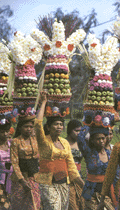|
Balinese Festival
Days
Galungan and Kuningan
Every six months the Balinese Hindus celebrate
the great day of Galungan when the ancestor spirits come down to the earth
to dwell again in the homes of their descendants. The spirits are entertained
and welcomed with prayers and offerings.
 Penjors,
long bamboo poles are erected together with a little bamboo altar from
which hung a lamak, one of those beautiful mosaics on long strips of palm
leaf on all the roads and the gate of every home. Penjors,
long bamboo poles are erected together with a little bamboo altar from
which hung a lamak, one of those beautiful mosaics on long strips of palm
leaf on all the roads and the gate of every home.
Commerce practically ceases during the
Galungan days. Schools are closed, and the normal life of the village concentrates
exclusively upon the events surrounding this very sacred period. On the
Sunday before Galungan, called Panyekeban, green bananas are sealed in
huge clay pots. Lots of bananas are required for Galungan offerings, and
this treatment will ripen them quickly. The next day, called Penyajaan,
is devoted to make many colored cakes of rice dough (jaja) that are used
for offerings. The markets are full of jaja in many kinds, so the busy
housewife can buy them. On the day before Galungan or Penampahan, pigs,
chicken, ducks or even cows are slaughtered for the traditional Galungan
day feasts. Featured at these feasts is the traditional lawar, a spicy
mixed vegetable with finely ground meat and dozen of spices.
Galungan day is a time for prayers, the
kids wear new clothes and the whole of Bali went out for a great praying
at puras or merajans. The women dress in beautiful kebayas
and kambens (two or one half meters long, but slightly narrower than sarongs).
A woman always wraps her body with kamben tightly, so it will performs
a graceful figure. Some women make some pleats on their front side of kambens
and hold it with a flat hairpin alike. The men wear white clothes and destar
(scarf that tied on the head). They also wearing kambens, but wrapped in
the different way with the women. When a man wraps the kamben he ends up
with a plaited fold that drapes down in front.
The day after Galungan is a time for visiting
friends and relatives, the roads are jammed with cars and motorcycles.
Then, ten days after Galungan, come Kuningan
day that marks the end of the Galungan celebration. There are still more
offerings, as the ancestor spirits return to heaven. On Kuningan the women
(housewives) usually make nasi kuning or yellow cooked rice made of rice,
spices and coconut milk. It tastes delicious especially if served with
lawar. Actually, the yellow cooked rice symbolizes the welfare of people
for the sake of God blesses, as the ripe rice color is yellow.
|